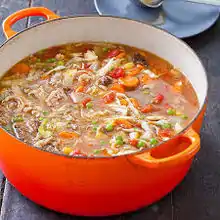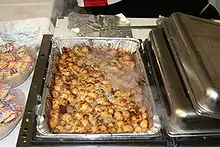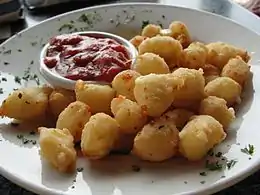The cuisine of Minnesota is a type of Midwestern cuisine found throughout the state of Minnesota in the United States of America.
Typical Minnesota cuisine is based off of Norwegian, Swedish, and German cuisine, with heavy Native American, particularly Ojibwe and Dakota, influences, such as the common usage of wild rice. Other European cuisines that influenced Minnesota cuisine include Czech, Cornish, Italian, and Polish cuisine. Since the 1960s to the present, Minnesota's cuisine has also been influenced by the cuisines of the various immigrant and refugee groups who have settled in Minnesota; immigrant cuisines popular in Minnesota include Somali, Hmong, Mexican, Indian, Vietnamese, Korean, Ethiopian, Burmese, Laotian, and Liberian cuisine.
Foods typical in Minnesota cuisine are generally affordable, and filling and hearty, reflecting Minnesota's long, cold winters. The majority of dishes are comfort foods. Meats in Minnesota cuisine typically include: Spam, white fish, walleye, pork, beef, turkey, chicken, salmon, trout, and cod. Grains such as corn, wild rice, and wheat are used. Canned fruits and vegetables are used in hotdishes and dessert salads. Minnesotan cuisine is notable for the common use of wild and foraged foods, including wild rice, blueberry, raspberry, blackberry, chokecherry, morels, hazelnuts, and pecan truffles. At the Minnesota State Fair dozens of foods are offered "on a stick", such as Pronto Pups and deep-fried candy bars. Though not typical Minnesota cuisine, these are archetypal fair foods.
Side Dishes
Gravlax, Spätzle, halušky, cabbage rolls, potato dumplings, and pierogis are very popular in Minnesota, all of which were brought by immigrants from Northern Europe. "Minnesotan sushi" is an appetizer that contains a pickle, covered in cream cheese and wrapped in ham, and cut into slices like sushi.
Potato salad, and pasta salad are often served in Minnesota. Corn on the cob made with sweet corn, mashed potatoes and gravy, asparagus, and green beans are Minnesota staples, often eaten at Thanksgiving or large dinners. French fries are often enjoyed with jucy lucys and corn dogs, along with other foods. Typical sides include pickles, jello salad, locally grown boiled new potatoes seasoned with fresh herbs or horseradish, baked beans, and vegetables buttered peas, carrots, and green beans. Preferred to rice or pasta, potatoes are often served alongside buttered rolls and homemade strawberry jam.
Soups

Minnesotan soups include booyah, which is a thick stew. Booyah can require up to two days and multiple cooks to prepare; it is cooked in specially designed "booyah kettles" and usually meant to serve hundreds or even thousands of people. In cooking booyah, one makes a base or broth derived from meat bones, to which vegetables are added. Beef, chicken, and pork are popular varieties of meat for booyah (with all three often in the same kettle), with vegetables such as carrots, peas, onion, and potatoes also in the mix. A wide variety of seasonings are used.
Some soups proposed as the Minnesota state soup include: cream of mushroom, Cream of lutefisk and wild rice soup, all of which include either ingredients from Minnesotan cuisine or are popular in the state.[1][2] Pho is a soup dish consisting of broth, rice noodles, herbs, and meat usually beef, and sometimes chicken. Pho was brought to Minnesota by Vietnamese immigrants. It is very popular in Minnesota and can be found in eateries around the Twin Cities.
Main dishes



- Lutefisk- is very popular in Minnesota, and is often eaten during Christmas. Lutefisk is dried whitefish. Usually cod is used, but ling and burbot are also used. It is made from aged stockfish (air-dried whitefish), or dried and salted cod, cured in lye. Lutefisk is traditionally served with boiled potatoes, mashed green peas, melted butter and small pieces of fried bacon. Madison, Minnesota has dubbed itself the "lutefisk capital of the world" as well as claiming the largest per capita consumption of lutefisk in Minnesota. It is also used to make cream of lutefisk soup. It was brought to Minnesota by Norwegian immigrants.[3]
- Rømmegrøt- is a thick and rich porridge made with sour cream, whole milk, wheat flour, butter, and salt. It is generally drizzled in butter and sprinkled with sugar and ground cinnamon. It can be eaten with cured meat. It was brought to Minnesota by Norwegian immigrants.
- Swedish meatballs- Swedish meatballs are called meat buns. They are usually made with a mix of ground beef and ground pork, or just with ground beef, which is mixed into a mixture of beaten eggs, breadcrumbs soaked in milk, and grated raw onions or finely chopped and fried onions. Cream is often added for more luxurious versions. The meatball mixture is seasoned with salt and white pepper or a mixture of white pepper and allspice. Swedish meatballs are traditionally served with gravy, boiled or mashed potatoes, lingonberry jam, and sometimes pickled cucumber. It was brought to Minnesota by Swedish immigrants.[4]
- hoppel poppel- is an egg casserole made with leftovers. the casserole dish is associated with the Midwestern United States. The basic recipe for the casserole is home fries (fried potatoes), scrambled eggs, and onion. Sometimes it is topped with melted cheese. Other ingredients like green pepper or mushrooms can be added to the basic combination, and a variety of meats can be used including bacon, ham and salami.The basic form of the dish was just potatoes, onions, meat and scrambled eggs, but more elaborate variations could be devised with green peppers, melted cheese and mushrooms. The meat could be ham, bacon, sausage, or even all-beef salami.It was brought to Minnesota by German immigrants.
- Pasties- It is made by placing an uncooked filling, typically meat and vegetables, in the middle of a flat shortcrust pastry circle, bringing the edges together in the middle, and crimping over the top to form a seal before baking. They are popular in the iron range of Minnesota.
- Hotdish- is a casserole dish that typically contains a starch, a meat, and a canned or frozen vegetable mixed with canned soup that must be served hot or warm. the most popular varieties in Minnesota are tater tot, tuna, chicken, hamburger, and wild rice hotdish. They were invented in Minnesota or the Upper Midwest; it is one of Minnesota's most iconic dishes.[5]
- Tater Tot Hotdish- is made with ground beef, topped with tater tots, and flavored with thick condensed cream of mushroom soup sauce, but some versions in Minnesota use the official state grain wild rice, or even macaroni, in place of the potatoes.
- Hautedish- is a fancy variation of the hotdish, it is deconstructed and contains tater tots, short ribs, a cream of porcini sauce, topped with green beans, and mushroom-Parmesan salad. Unfortunately all restaurants serving this dish have closed.[6]
- Jucy Lucy- a burger with melted cheese in the patty.Two bars in Minneapolis, Minnesota, claim to be the inventor of the burger, while other bars and restaurants have created their own interpretations of the style. In a jucy lucy both patties around the cheese to create a single patty with a cheese core. As the burger cooks, the cheese inside melts. This has the effect of keeping the meat near the center of the burger very juicy. It also separates the cheese from the bun, resulting in a slightly different texture than the usual cheeseburger. Burger toppings such as condiments, onions, and pickles may be added. It was invented in Minneapolis and is one of the most iconic dishes in Minnesota.[7]
- corn dogs- a sausage on a stick that is deep fried in corn batter. Another variety eaten in Minnesota is the corn brat, a brat on a stick that is fried in cornmeal. Corn dogs are very popular in Minnesota, and are a common state fair food.
- Minneapolis-style pizza- a thin crust pizza, cut into squares, with hearty toppings. It is popular in Minneapolis and the rest of Minnesota, with several chain restaurants offering the style.[8]
- Minneapolis-style hotdog- is a hotdog with a poppy seed bun, hotdish, tater tots, and ketchup. It also can include a sting of cheese.[9]
- walleye fingers- pieces of cut up walleye that are deep fried. They are especially popular in Minnesota because they are the state fish. It can also be served as a sandwich in Minnesota's pubs where the fish is very popular, deep fried walleye on a stick is a Minnesota State Fair food.
- Porketta sandwich- is a sandwich consisting of slow roasted, season pork. It is served on a sandwich with greens (rapini or spinach) and provolone cheese. Porketta remains a popular local dish in towns such as Hibbing, Minnesota with distributors such as Fraboni Sausage.
- Baked Penne- is a baked pasta dish consisting of cream cheese, penne pasta, and marinara sauce, it can also be sprinkled with mozzarella and Parmesan. There is also a special variation of baked penne in Minnesota consisting of sausage, ham, and a spicy marinara sauce that is also used on Minneapolis-style pizza.
Beverages
Craft root beer is popular in Minnesota and there are many brands in Minnesota such as Killebrew, Lift Bridge, and Northern Craft Root beer. Milk is very important for making cheese in Minnesota, it is also the state beverage.
The Bootlegger cocktail was invented in Minnesota and remains popular today. Akvavit was brought from Scandinavia by immigrants and is produced in numerous distilleries. The Minnesota Slammer, a popular cocktail in Minnesota, is made with cherry brandy, sweet and sour mix, peach and sour apple schnapps, and lemon-lime soda.[10]
Minnesota is also home to several breweries, including Hamm's, Summit Brewing Company, Surly Brewing Company, and August Schell Brewing Company, which also produces Grain Belt.
Wine
Minnesota also produces Minnesota wines. The Minnesota Grape Growers Association (MGGA) is a statewide organization that promotes grape growing and winemaking in the state and also in cold-hardy climates. Minnesota is home to the International Cold Climate Wine Competition (ICCWC) hosted annually in partnership between MGGA and University of Minnesota. This is the only wine competition solely dedicated to the promotion of quality wines made mainly from cold-hardy grape varieties.
Desserts

Dessert bars, bundt cakes, cookie salad, dessert salads, Snickers salad, strawberry delight, South Minneapolis style vanilla ice cream, and glorified rice are desserts invented in Minnesota or the Midwest.[11][12]
other desserts brought to Minnesota by immigrants include: rosettes, krumkake, kransekake, marzipan, lebkuchen, gingerbread, stollen, Shoofly pies, poppy seed roll, kolaches, Smultring, German baked apples, hamantashen, Sandbakelse, and potica.
Blue Moon ice cream is also popular in Minnesota and throughout the Midwest.[13]
Snacks

- Minnesota-style cheese curds are very popular, they are often served battered and deep fried.[14]
- licorice- is a confection usually flavored and colored black with the extract of the roots of the licorice plant Glycyrrhiza glabra. It is a popular candy in Minnesota it was also purposed as the state candy.
- Spam- is salty processed canned pork and ham. It is made and was invented in Minnesota. It can be eaten in many ways, but also plain as a snack.[15]
- polish sausage- is very popular served cold as cold cuts on a platter, usually for an appetizer. It is also a common snack served with beer or plain vodka.
- Lingonberries- is a berry that is used to accompany lefse and lutefisk. The berry can also be eaten plain as a snack.
- sauerkraut- sliced and fermented cabbage, was brought to Minnesota by German immigrants.
- Potato pancakes- are shallow-fried pancakes of grated or ground potato, matzo meal or flour and a binding ingredient such as egg or applesauce, often flavored with grated garlic or onion and seasonings. They may be topped with a variety of condiments, ranging from the savory (such as sour cream or cottage cheese), to the sweet (such as apple sauce or sugar).
- latkes- are fried potato pancakes or fritters. Brought by immigrants from Central or Eastern Europe.
- Pizza rolls- are a popular snack food in Minnesota.
Other Dishes

The Minnesota Agricultural Experiment Station's Horticultural Research Center at the University of Minnesota has developed three new apple varieties, the Haralson, Honeycrisp, and the Sweetango. These fare well in the harsh Minnesota climate and are popular fruit.
Minnesota is known for its dairy industry. Cheeses in Minnesota are made with cow, sheep, or goat milk.[16] Caves of Faribault and Shepherd's Way Farms are among the Minnesota businesses that produce artisan cheese. Caves of Faribault has produced cave-aged cheeses in Faribault since 2001. Shepherd's Way, which began producing cheese in 1998.
- Friesago- a sheep cheese.[17]
- morcella- a sheep cheese which is sprinkled with morel mushrooms.[18]
- big woods blue- a blue cheese made with sheep milk.[19]
- Lefse- It is made with riced potatoes, can include all purpose (wheat) flour, and includes butter, and milk, cream, or lard. It is cooked on a large, flat griddle. In Minnesota it is typically made with potatoes. It is eaten plain or filled. The most common is adding butter and sugar to the lefse and rolling it up. Other options include adding cinnamon, or spreading jelly, lingonberries, or gomme on it. Scandinavian-American variations include rolling it with a thin layer of peanut butter and sugar, with butter and white or brown sugar, with butter and corn syrup, or with butter and salt, or with ham and eggs. Also eaten with beef and other savory items like ribberull and mustard, it is comparable to a tortilla. Lefse is a traditional accompaniment to lutefisk, and the fish is often rolled up in the lefse.[20]
- Blueberry Muffin- It is a popular breakfast food in Minnesota. It is also the state muffin.
- Wild rice- is a popular appetizer in Minnesota. It can be eaten in several "ways" such as in a soup or hotdish.
- bratwursts- Are eaten in hotdog buns or as corndogs.
- Rice pudding- is rice mixed with milk and other ingredients. It was brought to Minnesota by immigrants and is enjoyed as dinner or dessert.
Food as an event

Potlucks
Minnesota is known for its church potlucks, where hotdish is often served. Hotdish is any of a variety of casseroles, which are popular throughout the United States, although the term "hotdish" is used mainly in Minnesota, Wisconsin, North Dakota, and South Dakota. Hotdishes are filling comfort foods that are convenient and easy to make. Tater tot hotdish is popular, as is wild rice hotdish; Minnesota is one of the leading producers of wild rice. Dessert bars are also common at Minnesota potlucks. Other dishes include glorified rice, German baked apples and cookie salad.
Fish fry
The Friday night fish fry, often battered and fried perch or walleye, is traditional throughout Minnesota. It usually also includes french fries, coleslaw, macaroni salad, lemon slices, tartar sauce, hot sauce, malt vinegar and dessert. Some Native American versions are cooked by coating fish with semolina and egg yolk. Fish is often served on Friday nights during Lent, the Christian season of repentance, as a restaurant special or through church fundraisers.
Booyah
A booyah is a large gathering in which booyah stew is served, typically outdoors.[21] The annual booyah cook off is held in St. Paul.[22]
smorgasbord
smorgasbord is a buffet-style meal of Swedish origin. It is served with various hot and cold dishes. In Minnesota it is served with kolaches, potica, halušky and pierogis.
References
- ↑ "A lawmaker suggested giving Minnesota an official state soup". Bring Me The News. Retrieved October 27, 2023.
- ↑ "Lawmaker suggests state soup should be 'Cream of Lutefisk' – Bring Me The News". Bring Me The News. Retrieved October 27, 2023.
- ↑ Sudakov, Monika (March 24, 2016). "What In The Heck Is A Lutefisk, And Why Do Minnesotans Eat It?". The Daily Meal. Retrieved October 27, 2023.
- ↑ "What to Nosh in the North Star State: Minnesota's Most-Iconic Dishes". Food Com. Retrieved October 27, 2023.
- ↑ "What to Nosh in the North Star State: Minnesota's Most-Iconic Dishes". Food Com. Retrieved October 27, 2023.
- ↑ "HauteDish". Food Network. Retrieved October 27, 2023.
- ↑ "What to Nosh in the North Star State: Minnesota's Most-Iconic Dishes". Food Com. Retrieved October 27, 2023.
- ↑ "What is Minneapolis style pizza, exactly?". Discover The Cities. April 17, 2020. Retrieved October 27, 2023.
- ↑ V, Jonny VJonny (July 24, 2017). "Look out Chicago Hot Dog, Minneapolis has Created their own". Hot 104.7. Retrieved October 27, 2023.
- ↑ "Minnesota Slammer Cocktail". Matchup Menu. April 1, 2018. Retrieved November 17, 2023.
- ↑ Columnist, Amanda Stone | Globe (July 2, 2020). "Amanda Stone: In Minnesota, bars mean dessert, not drinks". Joplin Globe. Retrieved August 3, 2023.
- ↑ "The Minnesota cake: How and why to use your bundt pan". Twin Cities. February 28, 2017. Retrieved August 3, 2023.
- ↑ Hutton, Rachel (August 29, 2022). "Blue Moon ice cream, a Midwest cult favorite, has delicious mystery". Star Tribune. Retrieved August 3, 2023.
- ↑ "Where to Go in Minneapolis-St. Paul For the Best Cheese Curds". The Cheese Professor. May 23, 2022. Retrieved August 4, 2023.
- ↑ "SPAM | History, Ingredients, Taste, Influence, & Varieties | Britannica". www.britannica.com. September 29, 2023. Retrieved October 27, 2023.
- ↑ March, Stephanie (September 17, 2020). "Minnesota Cheeses for Your Cheeseboard". Mpls.St.Paul Magazine.
- ↑ "Friesago - Cheese.com". www.cheese.com. Retrieved August 4, 2023.
- ↑ "Morcella | Local Cheese From Minnesota". www.tasteatlas.com. Retrieved August 3, 2023.
- ↑ "Big Woods Blue - Cheese.com". www.cheese.com. Retrieved August 3, 2023.
- ↑ Spiers, Katherine (November 3, 2022). "Lefse Lives on in the Upper Midwest". Smart Mouth. Retrieved October 27, 2023.
- ↑ Score, Brenda (September 3, 2015). "Booyah, a rich and flavorful fall stew tradition of the Upper Midwest!". a farmgirl's dabbles. Retrieved August 3, 2023.
- ↑ "Booya | Minnesota food, Food, Booyah recipe". Pinterest. Retrieved August 3, 2023.